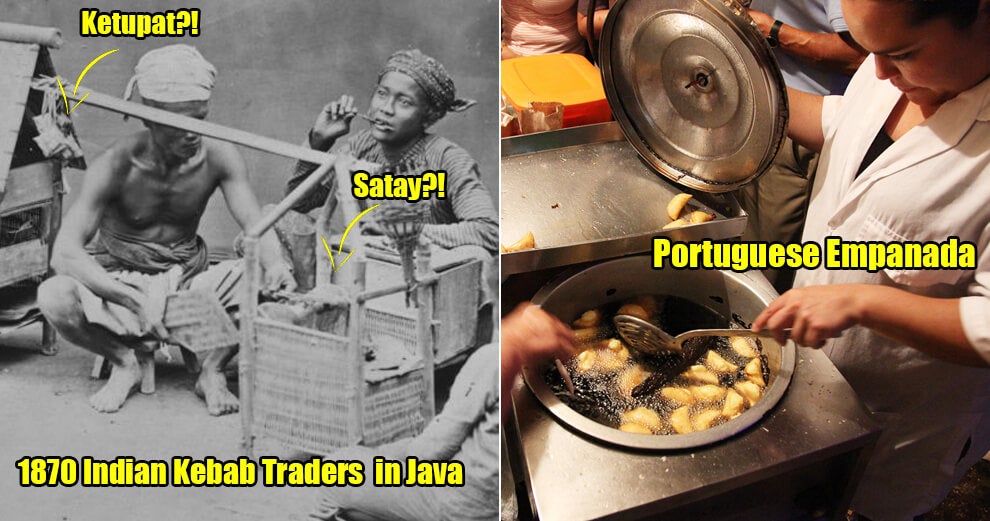Malaysia, as we all know, is a multiracial country and a food haven to many. We all love our Malaysian food and are true foodies at heart. But did you know that some of your favourite Malaysian foods were actually inspired by other countries? Serious okay, we are not lying. Here are 5 of them you absolutely must know about.
1. Putu Piring
View this post on Instagram
Putu Piring bears many similarities to Putu Mayam (string hoppers), a popular snack which originated in Tamil Nadu, India and it contains the same ingredients and toppings. What sets a Putu Piring apart though is its unique shape which is formed by conical moulds. Piring is also a Malay word for saucer, possibly referencing the miniature plates which are used in the steaming process.
![[Test] 5 Favourite Malaysian Foods You Probably Had No Idea Were Inspired by Other Countries - WORLD OF BUZZ 12](https://worldofbuzz.com/wp-content/uploads/2019/02/test-5-favourite-malaysian-foods-you-probably-had-no-idea-were-inspired-by-other-countries-world-of-buzz-13.jpg)
A putu piring merchant at a wet market in 1961 | Source: Pinterest
![[Test] 5 Favourite Malaysian Foods You Probably Had No Idea Were Inspired by Other Countries - WORLD OF BUZZ 13](https://worldofbuzz.com/wp-content/uploads/2019/02/test-5-favourite-malaysian-foods-you-probably-had-no-idea-were-inspired-by-other-countries-world-of-buzz-14.jpg)
A merchant pushing his cart of putu piring in 1960 | Source: Pinterest
Today, Putu Piring is a popular Malaysian snack enjoyed by many. Noteworthy mentions include Putu Piring Kluang in Kg. Bharu which is a trusted spot by locals for its sweet and creamy Putu Piring.
View this post on Instagram
2. Karipap or Epok-Epok
![[Test] 5 Favourite Malaysian Foods You Probably Had No Idea Were Inspired by Other Countries - WORLD OF BUZZ](https://worldofbuzz.com/wp-content/uploads/2019/02/test-5-favourite-malaysian-foods-you-probably-had-no-idea-were-inspired-by-other-countries-world-of-buzz.jpg)
While it’s difficult to tell when exactly Karipap or Epok-Epok first made an appearance on Malaysian tables, one thing is for sure: Curry Puff and Epok-Epok (the Malay version) aren’t the same. Some believe that the Curry Puff was inspired by the British Cornish pasty while Epok-Epok is said to be inspired by the Portuguese Empanada. Additionally, the shape of the Epok-Epok is made to resemble a crescent (a religious symbol in Islam) while the filling is flavoured in rempah (spices), not curry chicken and potato, like Curry Puffs. Noteworthily, Epok-Epok was also sold by itinerant hawkers on bicycles displaying these treats in glass cabinets mounted at the back in the ’70s.
![[Test] 5 Favourite Malaysian Foods You Probably Had No Idea Were Inspired by Other Countries - WORLD OF BUZZ 10](https://worldofbuzz.com/wp-content/uploads/2019/02/test-5-favourite-malaysian-foods-you-probably-had-no-idea-were-inspired-by-other-countries-world-of-buzz-11.jpg)
A lady selling a basket filled with various kuih in 1956 | Source: Pinterest
![[Test] 5 Favourite Malaysian Foods You Probably Had No Idea Were Inspired by Other Countries - WORLD OF BUZZ 11](https://worldofbuzz.com/wp-content/uploads/2019/02/test-5-favourite-malaysian-foods-you-probably-had-no-idea-were-inspired-by-other-countries-world-of-buzz-12.jpg)
A stall by the road selling an assortment of kuih in 1963 | Source: Pinterest
Be it Karipap or Epok-Epok, if you’re looking for something uniquely Malaysian, then you can’t go wrong with a visit to Kampong Kravers. Bringing you traditional hometown recipes passed down from one generation to another, a trip to Kampong Kravers is sure to satisfy your Malaysian Kravings.
View this post on Instagram
View this post on Instagram
3. Satay
View this post on Instagram
Contemporary scholars believe that the word Satay has Tamil origins and that while Thailand and Malaysia claim it as our own, its South East Asian origins can be traced back to the island of Java in the Indonesian archipelago. Historically, satay was developed from the Indian Kebab by Muslim traders which, in turn, contains influences from the Middle East. The history of satay surely is a complicated one — but what’s certain is that the snack coincided with the influx of Indian and Arab traders in Southeast Asia.
![[Test] 5 Favourite Malaysian Foods You Probably Had No Idea Were Inspired by Other Countries - WORLD OF BUZZ 8](https://worldofbuzz.com/wp-content/uploads/2019/02/test-5-favourite-malaysian-foods-you-probably-had-no-idea-were-inspired-by-other-countries-world-of-buzz-9.jpg)
A typical satay cart during the 1950s | Source: Pinterest
![[Test] 5 Favourite Malaysian Foods You Probably Had No Idea Were Inspired by Other Countries - WORLD OF BUZZ 9](https://worldofbuzz.com/wp-content/uploads/2019/02/test-5-favourite-malaysian-foods-you-probably-had-no-idea-were-inspired-by-other-countries-world-of-buzz-10.jpg)
A family enjoying a delicious satay dinner outing in the 1950s | Source: Pinterest
If you’re looking for a place to fix your satay cravings, then we highly recommend giving Satay Warisan 1951 in Kampung Baru a try. What makes this stall stand out is its addictive ‘sambal kacang’ sauce, tender meat, and juicy fat, making it truly worth raving about.
Well, if the place is just too far for you to drive, we’ll let you know a bit later on how you can get the juicy delicious satay to be delivered right to your doorstep!
View this post on Instagram
4. Rojak
View this post on Instagram
View this post on Instagram
Perhaps even more unclear is the origins of Rojak although scholars all seem to agree that it originated from the Malay archipelago (i.e. Malaysia, Brunei, Indonesia, Singapore, and the Philippines). One possible theory of its origins is that in ancient times, the natives of the Malay archipelago consumed seasonal tropical fruits along with sugar and salt to ease the sourness of the fruits. It is said that the introduction of peanuts and spicy chilli pepper in the snack was brought about due to the arrival of Spanish and Portuguese traders during the colonial era. Interestingly, Rojak is the earliest historically identified food of ancient Java.
![[Test] 5 Favourite Malaysian Foods You Probably Had No Idea Were Inspired by Other Countries - WORLD OF BUZZ 14](https://worldofbuzz.com/wp-content/uploads/2019/02/test-5-favourite-malaysian-foods-you-probably-had-no-idea-were-inspired-by-other-countries-world-of-buzz-15.jpg)
A typical make-shift rojak stall by the road in the 1950s | Source: Pinterest
In Malaysia, Rojak is a popular tea time snack with two variations: Mamak Rojak (also called Pasembur) and Rojak Buah (Fruit Rojak). If you are looking to satisfy your rojak cravings, two of our top recommendations are Hasan’s Rojak and Rojak & Cendol Mustaffa. Trust us, it’s truly worth the wait, or if you rather not wait in line, just order with GrabFood lah and they’ll deliver it to you!
View this post on Instagram
5. Laksa
View this post on Instagram
View this post on Instagram
According to scholars, the tradition of Laksa can be attributed to the arrival of Chinese traders in Southeast Asia. The descendants of these Chinese were called the Peranakans who had a strong desire to marry traditional Chinese food with Southeast Asian flavours such as coconut milk and chillies — ultimately resulting in the Laksa. In fact, the arrival of Laksa in Malaysia can be traced back to the 19th century when Chinese traders began marrying local women in Melaka. And get this, “Laksa” originates from Sanskrit meaning, “one hundred thousand” which probably explains why the dish is so adaptable and comes in several variations (i.e. Assam, Curry, and Siamese).
![[Test] 5 Favourite Malaysian Foods You Probably Had No Idea Were Inspired by Other Countries - WORLD OF BUZZ 15](https://worldofbuzz.com/wp-content/uploads/2019/02/test-5-favourite-malaysian-foods-you-probably-had-no-idea-were-inspired-by-other-countries-world-of-buzz-16.jpg)
A Chinese merchant selling noodles and laksa in 1920s Singapore | Source: Pinterest
![[Test] 5 Favourite Malaysian Foods You Probably Had No Idea Were Inspired by Other Countries - WORLD OF BUZZ 17](https://worldofbuzz.com/wp-content/uploads/2019/02/test-5-favourite-malaysian-foods-you-probably-had-no-idea-were-inspired-by-other-countries-world-of-buzz-18.png)
A government official visiting a laksa stall in 1960s Singapore |Source: Pinterest
Whether it’s Assam, Curry or Siamese, one thing we can all agree on is that nothing beats a hot bowl of Laksa on a cold day. If you are on the hunt for a quality bowl of Laksa, be sure to check these places out:
- Lorong Seratus Tahun
- Penang Road Famous Teochew Chendul
View this post on Instagram
And there you go, five Malaysian foods you probably didn’t know were inspired by other countries and cultures. But no matter what influenced these dishes, they are now part of our culture and most of them are even listed as part of the Malaysian cultural heritage.
Not that we’re complaining, they’re all super delicious and we love them all! The best part? They’re all available on GrabFood!
Yes, even the Putu Piring that’s hard to find is also available weh! Just order je lah, they’ll deliver it.
![[Test] 5 Favourite Malaysian Foods You Probably Had No Idea Were Inspired by Other Countries - WORLD OF BUZZ 7](https://worldofbuzz.com/wp-content/uploads/2019/02/test-5-favourite-malaysian-foods-you-probably-had-no-idea-were-inspired-by-other-countries-world-of-buzz-8-1024x682.jpg)
What can we say, it’s the best service for lazy Malaysians like you and me who emphasise on convenience. Bonus: no need to get dressed to drive out for food anymore!
An expert on local food, GrabFood is always prepared to satisfy your Malaysian cravings, bringing you your favourite local fares right to your doorstep. From Asam Pedas and Pisang Goreng to Nasi Lemak and Nasi Campur, it’s all just a few clicks away via GrabFood!
So, let your favourite meals come to you instead of going to them. Just order lah, GrabFood will deliver it!
Try it today with the promo code ‘FEAST’ to enjoy 50% discount* off your GrabFood order. Discount is capped at RM30 and only up to 3 usages per person! Valid for both new and existing GrabFood users.
*T&C applies, click here for more information.
Awesome! Download the GrabFood app on your phone if you haven’t already and have your favourite Malaysian food delivered directly to your doorstep today!


![[Test] Think Crispy Rendang is Madness? Here’s 5 Other Times Foreigners Got M’sian Food All Wrong - WORLD OF BUZZ 4](https://worldofbuzz.com/wp-content/uploads/2019/01/test-think-crispy-rendang-is-madness-heres-5-other-times-foreigners-got-msian-food-all-wrong-world-of-buzz-5.jpg)
































